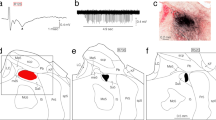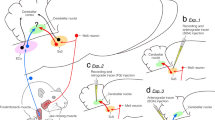Summary
The effects of electrical stimulation of the fornix, snout, and limbs on the activity of electrophysiologically identified Purkinje cells were investigated. Extracellularly recorded responses were analyzed according to: latency; mode of termination as mossy or climbing fibers; and, whether excitatory or inhibitory responses were evoked. The positions of responsive cells were transposed onto a planar representation of the Purkinje cell layer of the rat cerebellum derived from a series of sagittal sections.
Fornix responsive cells were found in the vermis of lobules IV, V, VI, and VII as well as in the paravermal regions of lobules II–VIIb. In addition, some evidence was obtained for a projection to lobulus simplex. Snout stimulation activated cells mainly in the vermis of lobule VI and also in adjacent lobules III, IV, V, and VIIa. A few responsive cells were also found in the paravermal regions of lobules V, VI, and VIIa and in the lateral portion of lobulus simplex. Forelimb responsive cells were located mainly in the vermis of lobules IV–VIa and in the paravermal portion of lobules III–VII. The few hindlimb cells encountered were located in the vermis and paravermis of lobules II–IV.
The topographical overlap of the fornix projection with areas in receipt of forelimb, snout, neck, and auditory-visual teleceptor input suggests that the fornix-mediated information may modulate cerebellar circuits involved in postural adjustment, general orienting, and exploratory motor behavior.
Similar content being viewed by others
References
Allen GI, Tsukahara N (1974) Cerebrocerebellar communication systems. Physiol Rev 54: 957–1006
Ariens Kappers CU, Huber GC, Crosby EC (1936) The comparative anatomy of the nervous system of vertebrates, including man, vols I and II. McMillan, New York
Armstrong DM (1974) Functional significance of the connections of the inferior olive. Physiol Rev 54: 358–417
Armstrong DM, Harvey RJ, Schild RF (1973) Spino-olivocerebellar pathways to the posterior lobe of the cat cerebellum. Exp Brain Res 18: 1–18
Batini C, Buisseret P, Kado RT (1974) Extraocular proprioceptive and trigeminal projections to the Purkinje cells of the cerebellar cortex. Arch Ital Biol 112: 1–17
Berthoz A, Llinás R (1974) Afferent neck projection to the cat cerebellar cortex. Exp Brain Res 20: 385–402
Black AH (1975) Hippocampal electrical activity and behavior. In: Isaacson RL, Pribram KH (eds) The hippocampus, vol II. Neurophysiology and behavior. Plenum Press, New York, pp 129–167
Bloedel J (1973) Cerebellar afferent systems. A review. Progr Neurobiol 2: 1–68
Boesten AJP, Voogd J (1975) Projections of the dorsal column nuclei and the spinal cord on the inferior olive in the cat. J Comp Neurol 161: 215–238
Brodai A, Brodai P (1971) The organization of the nucleus reticularis tegmenti pontis in the cat in the light of experimental anatomical studies of its cerebral cortical afferents. Exp Brain Res 13: 90–110
Brodai A, Jansen J (1946) The pontocerebellar projections in the rabbit and cat. Experimental investigations. J Comp Neurol 84: 31–118
Brown JT, Chan-Palay V, Palay SL (1977) A study of afferent input to the inferior olivary complex in the rat by retrograde axonal transport of horseradish peroxidase. J Comp Neurol 176: 1–22
Buchtel HA, Iosif G, Marchesi GF, Provini L, Strata P (1972) Analysis of activity evoked in the cerebellar cortex by stimulation of the visual pathways. Exp Brain Res 15: 278–288
Buchtel HA, Rubia FJ, Strata P (1973) Cerebellar unitary responses to moving visual stimuli. Brain Res 50: 463–466
Burne RA, Eriksson MA, Saint-Cyr JA, Woodward DJ (1978) Organization of the pontine projection to lateral cerebellar areas in the rat: dual zones in the pons. Brain Res 139: 340–347
Carpenter MB, Hanna GR (1961) Fiber projections from the spinal trigeminal nucleus in the cat. J Comp Neurol 117: 117–125
Clendenin M, Ekerot CF, Oscarsson O (1976) The lateral reticular nucleus in the cat. IV. Activation from dorsal funiculus and trigeminal afferents. Exp Brain Res 24: 131–144
Cragg BG, Hamlyn LH (1959) Histologie connections and electrical and autonomie responses evoked by stimulation of the dorsal fornix in the rabbit. Exp Neurol 1: 187–213
Cruce JAF (1977) An autoradiographic study of the descending connections of the mammillary nuclei of the rat. J Comp Neurol 176: 631–644
Cupédo RNJ (1965) A trigeminal midbrain-cerebellar fiber connection in the rat. J Comp Neurol 124: 61–70
Domesick VB (1969) Projections from the cingulate cortex in the rat. Brain Res 12: 296–320
Dow RS (1939) Cerebellar action potentials in response to stimulation of various afferent connections. J Neurophysiol 2: 543–555
Dow RS, Anderson R (1942) Cerebellar action potentials in response to stimulation of proprioceptors and exteroceptors in the rat. J Neurophysiol 5: 363–371
Eccles JC (1970) The topography of the mossy and climbing fiber inputs to the anterior lobe of the cerebellum. In: Fields WS, Willis WD (eds) The cerebellum in health and disease. Green, St. Louis, pp 231–262
Fadiga E, Pupilli GC (1964) Teleceptive components of the cerebellar function. Physiol Rev 44: 432–486
Fanardjian VV, Donhoffer H (1963) An electrophysiological study of cerebello-hippocampal relationships in the unrestrained cat. Acta Physiol Acad Sci Hung 24: 321–333
Fox SS, Liebeskinde JC, O'Brien JH, Dingle RDH (1967) Mechanisms for modification of cerebellar and cortical afferent information. In: Adey WR, Tokizane T (eds) Structure and function of the limbic system. Progr Brain Res 27: 254–280
Green JD, Morin F (1953) Hypothalamic electrical activity and hypothalamo-cortical relationships. Am J Physiol 192: 175–186
Guillery RW (1957) Degeneration in the hypothalamic connexions of the albino rat. J Anat 91: 91–115
Johnson TN (1965) An experimental study of the fornix and hypothalamo-tegmental tracts in the cat. J Comp Neurol 125: 29–40
Larsell O (1934) Morphogenesis and evolution of the cerebellum. Arch Neurol Psychiat 31: 373–395
Larsell O (1952) The morphogenesis and adult pattern of the lobules and fissures of the cerebellum of the white rat. J Comp Neurol 92: 281–356
Martin GF, Dom R, King JS, Robards M, Watson CRR (1975) The inferior olivary nucleus of the opossum (Didelphis marsupialis virginiana), its organization and connections. J Comp Neurol 160: 507–534
Meibach RC, Siegel A (1975) The origin of fornix fibers which project to the mammillary bodies in the rat. A horseradish peroxidase study. Brain Res 88: 508–512
Miles TS, Cooke JD, Wiesendanger M (1974) Localization in the cerebellar hemisphere of climbing-fiber responses evoked from the trigeminal nerve in the cat. Can J Physiol Pharmacol 52: 1147–1153
Miles TS, Wiesendanger M (1975a) Organization of climbing fiber projections to the cerebellar cortex from trigeminal cutaneous afferents and from the SI face area of the cerebral cortex in the cat. J Physiol (Lond) 245: 409–424
Miles TS, Wiesendanger M (1975b) Climbing fiber inputs to cerebellar Purkinje cells from trigeminal cutaneous afferents and the SI face area of the cerebral cortex in the cat. J Physiol (Lond) 245: 425–445
Mulhouse OE (1969) A Golgi study of the descending medial forebrain bundle. Brain Res 15: 341–363
Mitra J, Snider RS (1975) Effects of hippocampal afterdischarges on Purkinje cell activity. Epilepsia 16: 235–243
Morin F, Green JD (1953) Diffuse afterdischarges following stimulation of the fimbria hippocampi. Am J Physiol 175: 251–257
Murphy JT, Sabah NH (1970) Spontaneous firing of cerebellar Purkinje cells in decerebrate and barbiturate anesthetized cats. Brain Res 17: 515–519
Nauta WJH (1956) An experimental study of the fornix system in the rat. J Comp Neurol 104: 247–272
Nauta WJH (1958) Hippocampal projections and related neural pathways to the midbrain in the cat. Brain 81: 319–340
Newman PP, Reza H (1979) Functional relationships between the hippocampus and the cerebellum: An electrophysiological study of the cat. J Physiol (Lond) 287: 405–426
O'Keefe J (1976) Place units in the hippocampus of freely moving rats. Exp Neurol 51: 78–109
Puro DG, Woodward DJ (1977a) Maturation of evoked climbing fiber inputs to rat cerebellar Purkinje cells. I. Exp Brain Res 28: 85–100
Puro DG, Woodward DJ (1977b) Maturation of evoked mossy fiber input to rat cerebellar Purkinje cells. II. Exp Brain Res 28: 427–441
Ramón y Cajal S (1909–1911) Histologie du système nerveux de l'homme et des vertébrés, vols I and II. Consejo de Investigaciones Cientificas, Madrid. Paris, Maloine, Edition Française
Ranck JB, Jr (1973) Studies on single neurons in the dorsal hippocampal formation and septum in unrestrained rats. I. Behavioral correlates and firing repertoires. Exp Neurol 41: 462–531
Ron S, Robinson DA (1973) Eye movements evoked by cerebellar stimulation in alert monkeys. J Neurophysiol 36: 1004–1022
Routtenberg A (1971) Stimulus processing and response execution: a neurobehavioral theory. Physiol Behav 6: 589–596
Sager O, Florea-Ciocoiu V, Rogozea R (1970) Study of auditory projections to cerebellum and some cerebello-hippocamponeocortical circuits. Int J Neurol 7: 218–231
Saint-Cyr JA (1977) Limbic-cerebellar interrelations in the albino rat: an anatomical and physiological study. Doctoral dissertation, University of Rochester, Rochester, NY
Saint-Cyr JA, Courville J (1978) Topography of descending projections to the inferior olive from the parafascicular region, mesencephalon, and superior colliculus in the cat. Neurosci Abstr 4: 68
Saint-Cyr JA, Woodward DJ (1976) The limbic midbrain as a relay between limbic cortex and cerebellum in the rat as demonstrated by the retrograde transport of horseradish peroxidase. Neurosci Abstr 2: 396
Saint-Cyr JA, Woodward DJ (1980) Activation of mossy and climbing fiber pathways to the cerebellar cortex by stimulation of the fornix in the rat. Exp Brain Res 40: 1–12
Shofer RJ, Nahvi MJ (1969) Firing patterns induced by sound in single units of the cerebellar cortex. Exp Brain Res 8: 327–345
Smith GE (1896) The “fornix superior”. J Anat Physiol 31: 80–94
Smith GE (1897) The relation of the fornix to the margin of the cerebral cortex. J Anat Physiol 32: 23–58
Snider RS (1950) Recent contributions to the anatomy and physiology of the cerebellum. Arch Neurol Psychiat (Chicago) 64: 196–219
Snider RS, Stowell A (1944a) Receiving areas of the tactile, auditory, and visual systems in the cerebellum. J Neurophysiol 7: 331–357
Snider RS, Stowell A (1944b) Electro-anatomical studies on a tactile system in the cerebellum of monkey (Macaca mulatta). Anat Rec 88: 457
Swanson LW, Cowan WM (1977) An autoradiographic study of the organization of the efferent connections of the hippocampal formation in the rat. J Comp Neurol 172: 49–84
Valenstein ES, Nauta WJH (1959) A comparison of the distribution of the fornix system in the rat, guinea pig, cat, and monkey. J Comp Neurol 113: 337–363
Vanderwolf CH (1971) Limbic-diencephalic mechanisms of voluntary movement. Psychol Rev 78: 83–113
Zeman W, Innes JRM (1963) Craigie's neuroanatomy of the rat. Academic Press, New York
Author information
Authors and Affiliations
Additional information
This work was supported by N.S.F. Grant No. 77-01174 awarded to Dr. Donald J. Woodward, and an award from the Biological Humanics Foundation
Rights and permissions
About this article
Cite this article
Saint-Cyr, J.A., Woodward, D.J. A Topographic analysis of limbic and somatic inputs to the cerebellar cortex in the rat. Exp Brain Res 40, 13–22 (1980). https://doi.org/10.1007/BF00236658
Received:
Issue Date:
DOI: https://doi.org/10.1007/BF00236658




